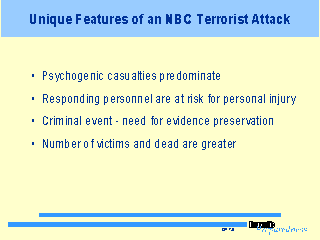|
|
|
|
front |1 |2 |3 |4 |5 |6 |7 |8 |9 |10 |11 |12 |13 |14 |15 |16 |17 |18 |19 |20 |21 |22 |23 |24 |25 |26 |27 |28 |29 |review |
 |
- Psychogenic casualties will predominate. These individuals will quickly overwhelm existing resources, and their presenting signs and symptoms may confuse the clinical picture. Once clinical injury has been ruled out, a crisis team of psychiatric assessment specialists should continue the evaluation in a more controlled setting. - Responding personnel are at risk for personal injury and secondary contamination. The strategically placed secondary explosive that detonated recently in Georgia (January 1997) reinforced the vulnerability of first responders. Hospital personnel are not immune from such an attack. - An intentional attack is a criminal event and “everything” becomes evidence. The emergency team must be aware of the importance of properly collecting and handling evidence (“chain of evidence”). - A well planned and executed terrorist NBC attack may result in thousands of casualties. |